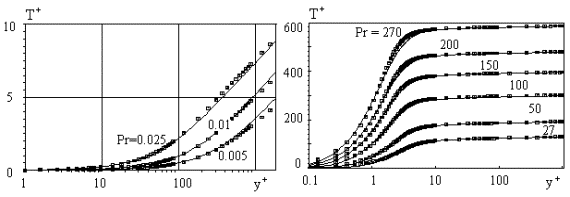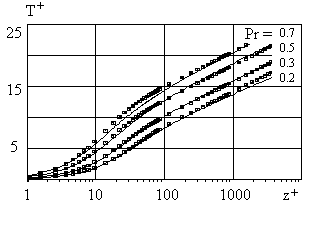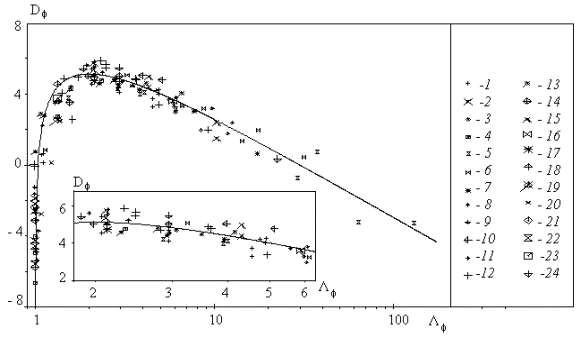Fluid Mechanics
Thermal boundary layer
The
constructive model of turbulence was developed to estimate the turbulent
transport of heat in the boundary layer. This model is based on two
assumptions:
1)
the
turbulent mixing parameter c depends on the transition layer scales;
2)
the
mean temperature profile depends on the thermal sublayer scale ![]() as well as on
the transition layer scales (here Pr is the Prandtl number, kh
is the constant that approximately equals to the von Karman's constant).
as well as on
the transition layer scales (here Pr is the Prandtl number, kh
is the constant that approximately equals to the von Karman's constant).
With this assumptions
the mean temperature gradient in a steady turbulent flow with the heat flux applied to the wall can be written in the form:

where ![]() , Tg is the wall temperature, T is
the turbulent flow temperature,
, Tg is the wall temperature, T is
the turbulent flow temperature, ![]() is the scale of
temperature, qH is the heat flux from the wall to the flow, cp is the
specific heat at constant pressure of the gas,
is the scale of
temperature, qH is the heat flux from the wall to the flow, cp is the
specific heat at constant pressure of the gas, ![]()
![]()
![]() is the parameter
dependent on the Prandtl number. As it was established the parameter
Pt(Pr) can be approximated in the range of the Prandtl number
2<Pr<1000 as follows:
is the parameter
dependent on the Prandtl number. As it was established the parameter
Pt(Pr) can be approximated in the range of the Prandtl number
2<Pr<1000 as follows: ![]() .
.
The boundary conditions on smooth wall and for the long distance from the wall are given by

The estimated mean temperature profiles are shown in Figure 1 by solid lines together with the profiles computed on the model of Sebeci (1972) - they are shown by square symbols. The agreement between two models in general is good. The constant kh and the temperature profiles also were calculated in the range 0.4<Pr<1.5 - see Figure 2.

Figure 1.
The estimated mean temperature profiles (solid lines) in the turbulent boundary
layer at small Prandtl number (left) and at large Prandtl number (right). The
square symbols -the model of Sebeci (1972).


Figure 2. The ratio ![]() versus the
molecular Prandtl number and the estimated mean temperature profiles (solid
lines).
versus the
molecular Prandtl number and the estimated mean temperature profiles (solid
lines).
Turbulent boundary layers
in roughened tubes


Figure 3. Roughness density effect on the turbulent flow in a case of 2D roughness
elements: the experimental data of various authors listed in Table 1 are shown
with symbols 1-24. The universal roughness density parameter depends on
the Dvorak's parameter as follows ![]() , here f is
the re-circulation zones parameter:
, here f is
the re-circulation zones parameter:
![]() .
.
The
mean velocity profile is given by ![]() where
where
![]() . Here b1 =0.12.
. Here b1 =0.12.
Table 1
|
Authors |
Year |
Geometry |
|
|
Symbol |
|
Möbius |
1940 |
Tube |
10.0-29.22 |
0.3-2.20 |
3 |
|
Chu
& Streeter |
1949 |
Tube |
1.95-7.57 |
0.93 |
4 |
|
Sams |
1952 |
Tube |
2.0-2.3 |
0.88-1.37 |
9 |
|
Nunner |
1956 |
Tube |
16.36 |
0.8 |
16 |
|
Koch |
1958 |
Tube |
9.8-980 |
1.0-5.0 |
5 |
|
Fedynskii |
1959 |
Annulus |
6.67-16.7 |
1.0 |
10 |
|
Draycott
& Lawther |
1961 |
Annulus |
2.0 |
1.0 |
2 |
|
Skupinski |
1961 |
Annulus Tube |
2.0-41.0 22.2-133.4 |
1.0 2.0 |
6 |
|
Savage
& Myers |
1963 |
Tube |
3.66-43.72 |
1.33-2.67 |
13 |
|
Perry
& Joubert |
1963 |
Wind
tunnel |
4.0 |
1.0 |
19 |
|
Sheriff,
Gumley & France |
1963 |
Annulus |
2.0-10.0 |
1.0 |
14 |
|
Gargaud
& Paumard |
1964 |
Tube Annulus |
1.8-16.0 10.0-16.0 |
1.0-1.67 1.0 |
1 |
|
Bettermann |
1966 |
Wind tunnel |
2.65-4.18 |
1.0 |
20 |
|
Massey |
1966 |
Annulus |
7.53-30.15 |
1.06 |
15 |
|
Kjellström &
Larson |
1967 |
Annulus |
2.02-38.52 |
0.086-4.08 |
12 |
|
Fuerstein & Rampf |
1969 |
Annulus |
2.91-25.04 |
0.42-2.50 |
8 |
|
Lawn
& Hamlin |
1969 |
Annulus |
7.61 |
1.0 |
17 |
|
Watson |
1970 |
Annulus |
6.49-7.22 |
1.0 |
11 |
|
Stephens |
1970 |
Annulus |
7.20 |
1.0 |
18 |
|
Webb, Eckert &
Goldstein |
1971 |
Tube |
9.70-77.63 |
0.97-3.88 |
7 |
|
Antonia
& Luxton |
1971 |
Wind
tunnel |
4.0 |
1.0 |
21 |
|
Antonia
& Wood |
1975 |
Wind
tunnel |
2.0 |
1.0 |
22 |
|
Dalle
Donne & Meyer |
1977 |
Annulus |
4.08-61.5 |
0.25-2.0 |
24 |
|
Pineau, Nguyen,
Dickinson & Belanger |
1987 |
Wind
tunnel |
4.0 |
1.0 |
23 |
To read more
about the turbulent flows over rough surfaces please copy Chapter3.zip file 556K
with MS Word97 doc Model of turbulent flows over rough
surfaces by A P Trunev .
The computed mean velocity profiles
together with the experimental data by Nagano et al (1992) are shown in Figure 4.
To read more about the constructive theory of turbulence copy ZIP file (261K) with MS Word2000 doc: "Theory and constants of wall turbulence" by A P Trunev.
References
Trunev A. P. Theory
of Turbulence, Russian Academy of Sciences, Sochi, 1999.
Cebeci T. 1973 A model for eddy conductivity and turbulent Prandtl
number, J. Heat Transfer, 95, 227.
Antonia, R.A.
& Luxton, R.E. 1971 The Response of a Turbulent Boundary
Layer to a Step Change in Surface Roughness, Pt. 1. Smooth to Rough. J. Fluid Mech., 48, 721-762.
Antonia, R.A.
& Wood, D.H. 1975 Calculation of a Turbulent Boundary layer
Downstream of a Step Change in Surface Roughness. Aeronautical Quarterly, 26,
3, 202-210.
Bettermann, D. 1966 Contribution
a l’Etude de la Convection Force Turbulente le Long de Plaques Regueuses. Int. J. Heat and Mass Transfer, 9, 153.
Cantwell, B. J., Coles D. &
Dimotakis, P. 1978 Structure and
entrainment in the plane of symmetry of a turbulent spot, J. Fluid Mech., 87, 641-672.
Cebeci, T. & Bradshaw, P. 1984 Physical
and Computational Aspects of Convective Heat Transfer, Springer-Verlag, NY.
Chu, H. &
Streeter, V.L. 1949 Fluid flow and heat transfer in
artificially roughened pipes. Illinois
Inst. of Tech. Proc. No. 4918.
Clauser, F. 1956 The Turbulent
Boundary Layer. Advances in Applied
Mechanics, vol. 4, pp.1-51.
Coleman, H. W., Hodge, B. K. &
Taylor, R. P. 1984 A Revaluation of
Schlichting’s Surface Roughness Experiment. J.
Fluid Eng. 106, 3.
Data-Base on Turbulent Heat Transfer/ Nagano Y., Kasagi N., Ota T., Fujita H., Yoshida H.,
Kumada M. Department of Mechanical Engineering, Nagoya Institute of Technology,
Nagoya. DATA No. FW BL004.
Dirling, R.B., Jr. 1973 A Method
for Computing Roughwall Heat-Transfer Rate on Re-Entry Nose Tips. AIAA Paper, 73-763.
Draycott, A.
& Lawther, K.R. 1961 Improvement of fuel element heat transfer
by use of roughened surface and the application to a 7-rod cluster. In Int. Dev. Heat Transfer, Part III, pp.
543-52, ASME, NY.
Donne, M. & Meyer, L. 1977 Turbulent
Convective Heat Transfer from Rough Surfaces with Two-Dimensional Rectangular
Ribs. Int. J. Heat Mass Transfer, Vol.
20, pp. 583-620.
Driest, E.R. Van . 1956 On turbulent flow near a wall. J. Aero. Sci. 23, 1007.
Dvorak , F. A. 1969 Calculation of
Turbulent Boundary Layer on Rough Surface in Pressure Gradient. AIAA Journal 7, 9.
Fedynskii, O.
S. 1959 Intensification of heat transfer to water in
annular channel. In Problemi
Energetiki, Energ. Inst. Akad.
Nauk USSR (in Russian).
Fuerstein, G. & Rampf, G. 1969 Der Einfluß rechteckiger Rauhigkeiten auf den Wärmeübergang und den
Druckabfall in turbulenter Ringspaltströmung. Wärme- und Stoffübertragung, 2 (1), 19-30.
Gargaud, I. & Paumard, G. 1964 Amelioration du transfer de chaleur par l'emploi de surfaces corruguees.
CEA-R-2464.
Grabov, R.M. & White, C.O. 1975 Surface Roughness
Effects on Nose Tip Ablation Characteristics, AIAA Journal, 13, pp.
605-609.
Jackson, P.S. 1981 On the displacement
height in the logarithmic wind profile. J. Fluid Mech., 111, 15-25.
Kind, R. J. & Lawrysyn, M. A. 1992 Aerodynamic
Characteristics of Hoar Frost Roughness.
AIAA Journal 30, 7, 1703-7.
Kjellström, B. & Larsson, A. E. 1967 Improvement
of reactor fuel element heat transfer by surface roughness. AE-271. Data
repoted by Dalle Donne & Meyer (1977).
Klebanoff, P. S. 1954
Characteristics of turbulence in a boundary layer with zero pressure gradient. NACA Tech. Note, 3178.
Koch, R. 1958
Druckverlust und Wärmeübergang bei verwirbelter Strömung. ForschHft. Ver. Dt. Ing. 469, Series B, 24, 1-44.
Kuroda, A., Kasagi, N. & Hirata, M. 1989 A direct Numerical
Simulation of the Fully Developed Turbulent Channel Flow. In International Symposium on Computational
Fluid Dynamics,
Nagoya, pp. 1174-1179.
Laufer, J. 1954 The structure of
turbulence in fully developed pipe flow. NACA
Tech. Note 2954.
Lawn, C. J. & Hamlin, M. J. 1969 Velocity
measurements in roughened annuli. CEGB RD/B/N 2404, Berkley Nuclear
Laboratories.
Massey, F.A. 1966 Heat transfer and flow
in annuli having artificially roughened inner surfaces. Ph. D. Thesis,
University of Wisconsin.
Monin, A.S. & Yaglom, A.M. 1965 Statistical Fluid Mechanics: Mechanics of
Turbulence. The MIT Press.
Möbius, H. 1940
Experimentelle Untersuchung des Widerstandes und der Gschwindig-keitsverteilung
in Rohren mit regelmäßig angeordneten Rauhigkeiten bei turbulenter Strömung. Phys. Z. 41, 202-225.
Nagano, Y.& Tagawa, M. 1991
Turbulence model for triple velocity and scalar correlation. In Turbulent Shear
Flows 7 (F. Durst, B. E. Launder, W. C. Reynolds, F. W., Schmidt, J. H.
Whitelaw, eds), Springer, Berlin, Heidelberg, New York , pp. 47-62.
Nagano, Y., Tagawa M. & Tsuji. T. 1992 Effects of Adverse
Pressure Gradients on Mean Flows and Turbulence Statistics in a Boundary
Layer. 8th Symposium on Turbulent Shear Flows proceedings.
Nikuradse, J. 1933 Strömungsgesetze in Rauhen Rohren. ForschHft. Ver. Dt. Ing.
361.
Nunner, W. 1956 Wärmeübergang und Druckabfall in rauhen Rohren. ForschHft. Ver. Dt. Ing. 455.
Osaka, H. & Mochizuki, S. 1989 Mean Flow
Properties of a d-type Rough Wall Boundary Layer in a Transitionally Rough and
a Fully Rough Regime. Trans. JSME ser. B, Vol.55,
No.511, 640-647.
Perry, A.E.
& Joubert, P.N. 1963 Rough-Wall Boundary Layers in Adverse
Pressure Gradients. J. Fluid Mech., 17, 2, 193-211.
Pineau, F., Nguyen, V. D., Dickinson,
J. & Belanger, J. 1987 Study of a Flow Over a Rough Surface with
Passive Boundary-Layer Manipulators an Direct Wall Drag Measurements. AIAA Paper, 87-0357.
Prandtl, L. 1933 Neuere Ergebnisse der Turbulenzforschung. VDI
-Ztschr. 77, 5, 105.
Raupach, M.R. 1992 Drag and drag
partition on rough surfaces, Boundary
Layer Meteorol., 60, 375-395.
Pulliam, T. H. & Steger, J. L. 1980 Implicit Finite-Difference Simulations
of three-dimensional Compressible Flow, AIAA
Journal 18, 2, 159.
Rotta, J.C. 1972 Turbulente Stromungen. Eine Einfuhrung in die Theorie und ihre Anwendung.
B. G. Teubner Stuttgart. P. 156.
Sams, E.W. 1952 Experimental investigation of average heat transfer and friction
coefficients for air flowing in circular tubes having square-thread-type
roughness. NACA RME 52 D 17.
Savage, D.W.
& Myers, J.E. 1963 The effect of artificial surface
roughness on heat and momentum transfer. A.I.Ch.E.J.,
9, 694-702.
Schlichting, H. 1936 Experimentelle Untersuchungen zum Rauhigkeits-problem. Ing.-Arch 7(1), 1-34.
Schlichting, H. 1960 Boundary Layer
Theory. McGraw-Hill, NY, p.527.
Sheriff, N.,
Gumley, P. & France, J. 1963 Heat transfer
characteristics of roughened surfaces. UKAEA, TRG Report 447 (R).
Sigal, A & Danberg, J.E. 1990 New
Correlation of Roughness Density Effect on the Turbulent Boundary Layer. AIAA
Journal, 25, 3, 554-556.
Simpson, R. L. 1973 A Generalized
Correlation of Roughness Density Effect on the Turbulent Boundary Layer. AIAA Journal 11,
9, 242-244.
Skupinski, E. 1961
Wärmeübergang und Druckverlust bei künstlicher Verwirbelung und künstlicher
Wandrauhigkeiten. Diss. Techn. Hochschule Aachen.
Smith, R.W. 1994 Effect of Reynolds
Number on the Structure
of Turbulent Boundary Layers. Ph.D. Thesis, Princeton
University, Princeton, NJ.
Stephens, M. J. 1970 Investigations of flow in a concentric annulus with smooth outer
wall and rough inner wall. CEGB RD/B/N 1535, Berkley Nuclear Laboratories.
Trunev, A. P. 1995 Diffuse processed in
turbulent boundary layer over rough surface. In Air Pollution III, Theory and Simulation (ed. H. Power, N.
Moussiopoulos & C.A. Brebbia). Comp. Mech. Pub. Southampton-Boston.
Trunev, A. P. 1996 Similarity theory for
turbulent flow over natural rough surface in pressure and temperature
gradients. In Air Pollution IV,
Monitoring, Simulation and Control, (ed. B. Caussade, H. Power & C.A.
Brebbia ).Comp. Mech. Pub. Southampton-Boston.
Trunev, A. P. 1997 Similarity theory and
model of diffusion in turbulent atmosphere at large scales. In Air Pollution V, Modelling, Monitoring and
Management. (ed. H. Power, T. Tirabassi & C .A. Brebbia) Comp. Mech.
Pub. Southampton-Boston.
Trunev, A. P. & Fomin, V.M. 1985 Continual
model of impingement erosion. J. Appl.
Mech. and Tech. Phys., 6, pp.
113-120.
Watson, M.A.P. 1970 The performance of a
square rib type of heat transfer surface. CEGB RD/B/N 1738, Berkeley Nuclear Laboratories.
Webb, R. L., Eckert, E.R.G. &
Goldstein, R. J. 1971 Heat transfer and friction in tubes with repeated-rib roughness. Int. J. Heat Mass Transfer, 14, 601-617.
Wieringa, J. 1992 Updating the
Davenport Roughness Clarification. J. Wind
Engineer. Industl. Aerodyn. 41,
357–368.